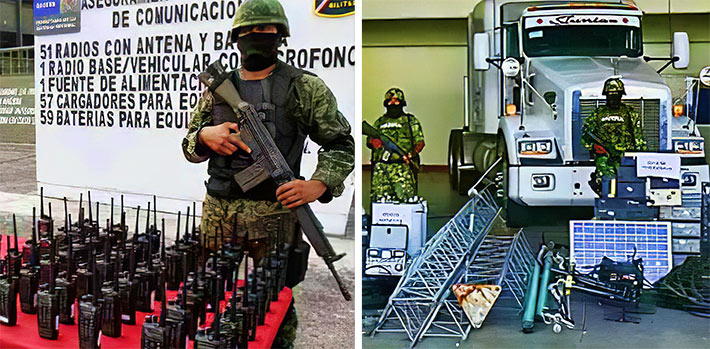
Cartels are getting a free tenancy on many of Mexico’s macro towers where their network’s “parasite” antennas are hidden from law enforcement. In 2012, the Mexican army seized hundreds of antennas and other network equipment. Authorities in past years are unable to ensure that tower techs are able to safely perform their work.
A tower tech in Mexico turned off the power to an American Tower site to perform routine maintenance and within minutes three armed men in fatigues embroidered with a prominent drug cartel logo braced him in the site’s compound since their “parasite” antennas on the structure for their narco-network went down.
He was released with a warning
“I was so nervous… Seeing them armed in front of you, you don’t know how to react,” the worker told Reuters in their extensive report published today, recalling the 2018 encounter.
“Little by little, you learn how to coexist with them, how to address them, how to make them see that you don’t represent a threat,” he said.
According to two engineers, anywhere between 20% to 30% of the towers in their market have the “parasite” antennas and frequently telecom workers are required to pay “security payments”.
An American Tower spokesperson informed Wireless Estimator that they have not received any credible reports of parasite antennas. He said American Tower alerts local authorities immediately if a site is vandalized, and that “the safety of those who work on our towers, as well as the towers’ continued secure operation, are our top priorities.”
Neither US-based Crown Castle, SBA Communications nor Vertical Bridge own structures in Mexico.
Traffickers often erect their own 25-G-type towers and antennas in rural areas, but in order to save money and evade detection since their own towers are more easily spotted and removed by law enforcement, the cartels are piggybacking on existing macro sites where their antennas are less visible.
As Wireless Estimator reported in 2012, one of Mexico’s largest drug traffickers, the Gulf Cartel, built out their network in most of Mexico’s 31 states and parts of northern Guatemala in a record six months in 2006.
The cartel employed a group of enforcers known as the Zetas, who split from the Gulf Cartel in 2010 and became one of the nation’s most dominant drug cartels.
The Zetas have since branched out with profitable sidelines such as kidnapping, extortion and human trafficking. Their wireless network makes those activities even easier to traffic in.
Zetas’ network is primarily an early warning reconnaissance system. “Halcons,” or “hawks,” holler on the handhelds when the federal police or soldiers roll through cartel territory.
Zetas operatives were able to conduct encrypted conversations without depending on the local cell phone network, which is relatively easy for the Mexican authorities to tap into.
Zetas divides up territory into “plazas.” The plaza boss has the responsibility for establishing nodes on the network — getting the antennas in place, concealing them as necessary, making sure the signal-boosting repeaters extend the network’s reach, equipping cartel personnel with handheld radios, and replacing what the security forces destroy.
Much of the Zetas’ equipment came from U.S. manufacturers or distributors. In remote locations where power wasn’t available, solar panels powered the transceivers.
The Mexican army seized a total of at least 167 antennas, 155 repeaters, 166 power sources, 71 pieces of computer equipment and 1,446 radios in 2012 but its enforcement is limited and inconsistent today in attempts to dismantle networks.
Confirmation of the illegal communications network was revealed when Jose Luis Del Toro Estrada, the network’s mastermind known as “Tecnico”, testified that he had built the system and provided some details of the network as part of a guilty plea agreement in the U.S. of conspiracy to distribute cocaine in federal court in Houston, Tex. in 2010.
Estrada maintained a staff of tower technicians tasked with building and maintaining the system.
According to Estrada, the parasite antennas have been used for years. He told authorities that he collocated his antennas on existing towers, including towers used by police stations, and used both directional and omni-directional antennas. He also employed specialists to research new technology to be able to have the most advanced system possible and to be able to monitor law enforcement activities.
The cartel’s multi-million-dollar network often changes the frequencies upon which the radios work

















